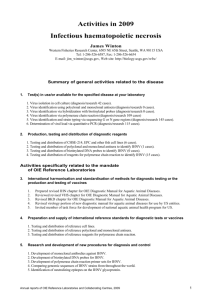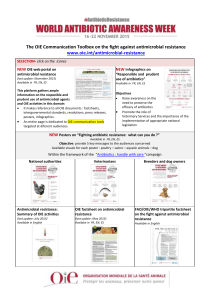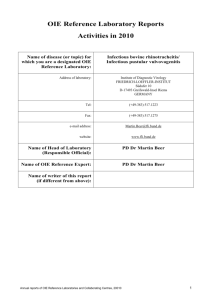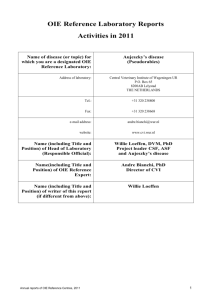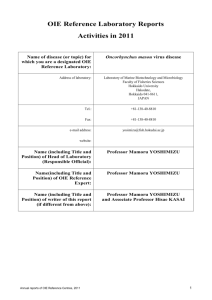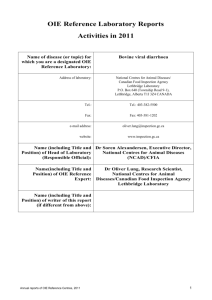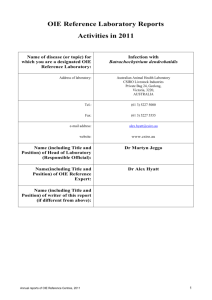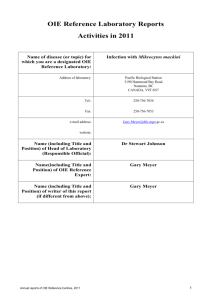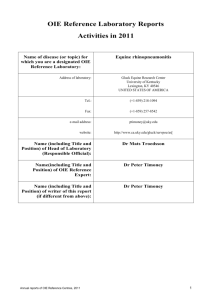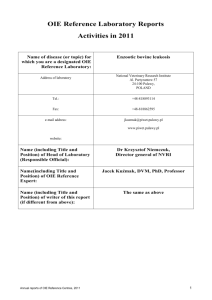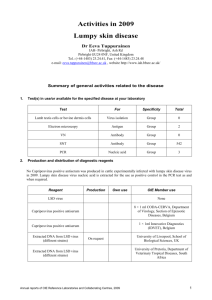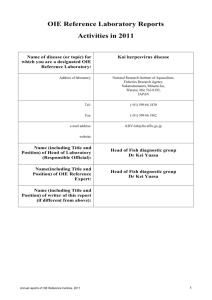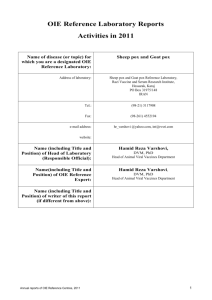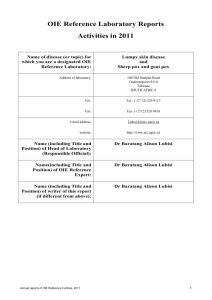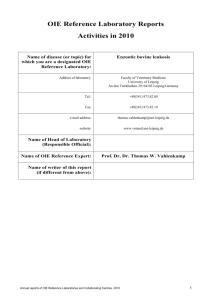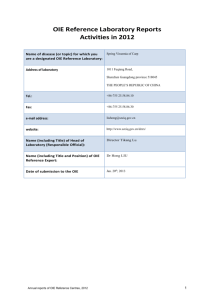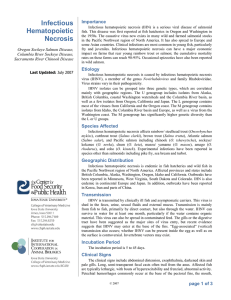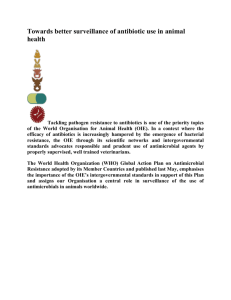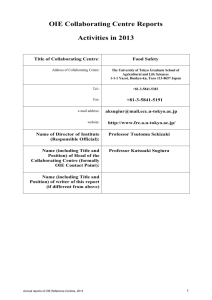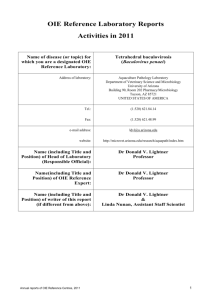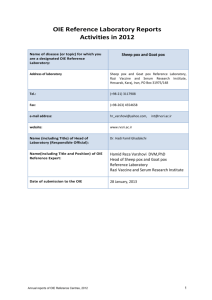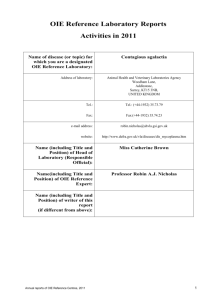Disease name
advertisement
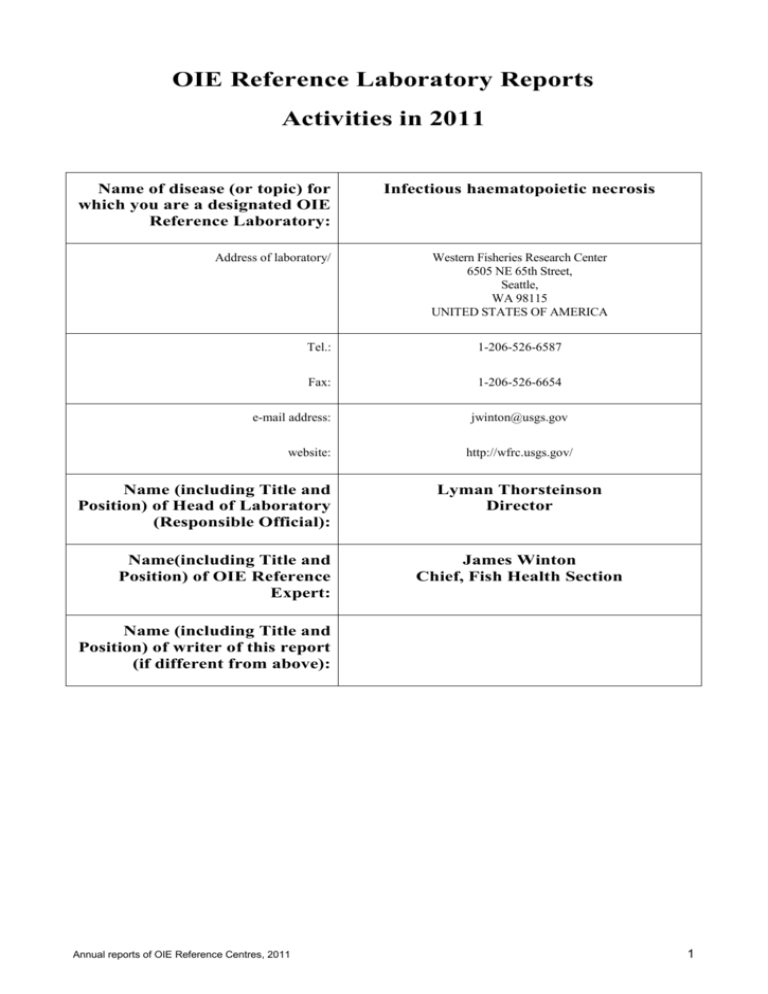
OIE Reference Laboratory Reports Activities in 2011 Name of disease (or topic) for which you are a designated OIE Reference Laboratory: Address of laboratory/ Infectious haematopoietic necrosis Western Fisheries Research Center 6505 NE 65th Street, Seattle, WA 98115 UNITED STATES OF AMERICA Tel.: 1-206-526-6587 Fax: 1-206-526-6654 e-mail address: website: Name (including Title and Position) of Head of Laboratory (Responsible Official): Name(including Title and Position) of OIE Reference Expert: jwinton@usgs.gov http://wfrc.usgs.gov/ Lyman Thorsteinson Director James Winton Chief, Fish Health Section Name (including Title and Position) of writer of this report (if different from above): Annual reports of OIE Reference Centres, 2011 1 Infectious haematopoietic necrosis Part I: Summary of general activities related to the disease 1. Test(s) in use/or available for the specified disease/topic at your laboratory 2. Virus isolation in cell culture (diagnosis/research 124 cases) Virus identification using polyclonal and monoclonal antisera (diagnosis/research 0 cases) Virus identification via hybridization with biotinylated probes (diagnosis/research 0 cases) Virus identification via polymerase chain reaction (diagnosis/research 359 cases) Virus identification and strain typing via sequencing G or N genes (diagnosis/research 537 cases) Determination of viral load via quantitative PCR (diagnosis/research 457 cases) Production and distribution of diagnostic reagents Testing and distribution of CHSE-214, EPC and other fish cell lines (6 cases) Testing and distribution of polyclonal and monoclonal antisera to identify IHNV (3 cases) Testing and distribution of biotinylated DNA probes to identify IHNV (0 cases) Testing and distribution of reagents for polymerase chain reaction to identify IHNV (5 cases) Part II: Activities specifically related to the mandate of OIE Reference Laboratories 3. International harmonisation and standardisation of methods for diagnostic testing or the production and testing of vaccines 4. a) Establishment and maintenance of a network with other OIE Reference Laboratories designated for the same pathogen or disease and organisation of regular inter-laboratory proficiency testing to ensure comparability of results b) Organisation of inter-laboratory proficiency testing with laboratories other than OIE Reference Laboratories for the same pathogens and diseases to ensure equivalence of results Preparation and supply of international reference standards for diagnostic tests or vaccines 5. Testing and distribution of reference cell lines Testing and distribution of reference polyclonal and monoclonal antisera Testing and distribution of reference reagents for standard and quantitative polymerase chain reaction assays Research and development of new procedures for diagnosis and control 2 Prepared revised IHN chapter for OIE Diagnostic Manual for Aquatic Animal Diseases Reviewed revised VHS chapter for OIE Diagnostic Manual for Aquatic Animal Diseases Revised virology portion of diagnostic manual for aquatic animal diseases for use by US agencies Invited member of task force for development of national aquatic animal health program for US Reviewed US surveillance plans for virus disease of fish Development of new polymerase chain reaction primer sets for IHNV Comparing genomic sequences of IHNV strains from throughout the world Identification of neutralizing epitopes on the IHNV glycoprotein Comparative challenge studies with various isolates of IHNV DNA vaccine studies in fish for control of IHN via genetic immunization Development of validated quantitative PCR assay for IHNV Development of quantitative PCR for trout cytokine genes involved in innate resistance to IHNV Development of strand-specific qPCR assay for messenger and genomic RNA species Annual reports of OIE Reference Centres, 2011 Infectious haematopoietic necrosis 6. Collection, analysis and dissemination of epizootiological data relevant to international disease control 7. Provide data and professional advice to US Dept of Agriculture for OIE Annual Report. Maintenance of a system of quality assurance, biosafety and biosecurity relevant to the pathogen and the disease concerned The WFRC represents a state-of-the-art center for work on infectious diseases of fish that includes over 16,000 square feet of laboratory space for virology, bacteriology, immunology, histology, parasitology, and molecular biology. The laboratory also houses a 9,000 square foot wet laboratory supplied with pathogen-free, temperaturecontrolled (5-25C) fresh water to a total of more than 300 tanks of various sizes. The laboratory effluent is treated with chlorine gas. Within the dry lab is a restricted access Biosafety Level 3 laboratory containing dry and wet laboratories for work with exotic fish pathogens. 8. Provision of consultant expertise to OIE or to OIE Member Countries 9. Provided advice to laboratory in China Provided advice to laboratory in India Provided advice to laboratory in Tunisia Provided advice to laboratory in Korea Provided advice to laboratory in Mexico Provision of scientific and technical training to personnel from other OIE Member Countries Hosted personnel from laboratories in Canada, Norway, Japan, Korea. 10. Provision of diagnostic testing facilities to other OIE Member Countries None. 11. Organisation of international scientific meetings on behalf of OIE or other international bodies None. 12. Participation in international scientific collaborative studies Participated in collaborative study with personnel from Department of Fisheries and Oceans, Canada. Participated in collaborative study with personnel from National Veterinary Laboratory, Denmark. Participated in collaborative study with personnel from National Veterinary Laboratory, Norway. 13. Publication and dissemination of information relevant to the work of OIE (including list of scientific publications, internet publishing activities, presentations at international conferences) Scientific publications in peer-reviewed journals Hart, L., G.S. Traxler, K.A. Garver, J. Richard, J.L. Gregg, C.A. Grady, G. Kurath and P.K. Hershberger (in press) Larval and juvenile Pacific herring Clupea pallasii are not susceptible to infectious hematopoietic necrosis. Dis. Aquat. Org. Kurath, G. and J. Winton (2011) Complex dynamics at the interface between wild and domestic viruses of finfish. Curr. Opin. Virol. 1:73-80. Annual reports of OIE Reference Centres, 2011 3 Infectious haematopoietic necrosis Kurath, G., K.A. Garver, M.K. Purcell, M.M. Peñaranda, R. Life and S.Rudakova (in press) Host specificity and ecology of infectious hematopoietic necrosis virus (IHNV) in Pacific salmonids. Proceedings of the Third USRussia Bilateral Conference on Aquatic Animal Health. Park, J.W., C.H. Moon, A.W. Wargo, M.K. Purcell, M.I. Thoulouze, M. Brement and G. Kurath (2011) Restricted growth of the U genogroup IHNV in rainbow trout cells is linked to casein kinase II activity. J. Fish Dis. 34:115129 Penaranda, M.M., A.R. Wargo and G. Kurath (2011) In vivo fitness correlates with host-specific virulence of Infectious hematopoietic necrosis virus (IHNV) in sockeye salmon and rainbow trout. Virology 417:312-319. Purcell, M.K., I.S. Marjara, W. Batts, G. Kurath and J.D. Hansen (2011) Transcriptome analysis of rainbow trout with high and low virulence strains of Infectious hematopoietic necrosis virus. Fish Shellfish Immunol. 30:84-93. _______________ 4 Annual reports of OIE Reference Centres, 2011
